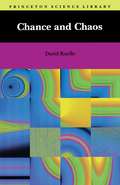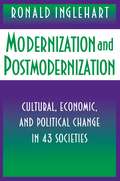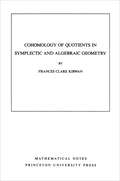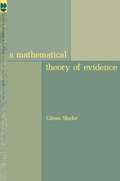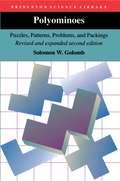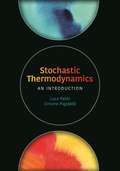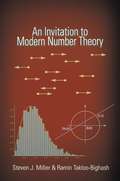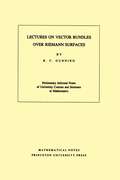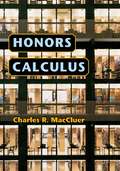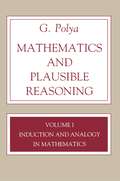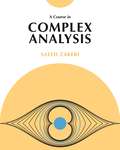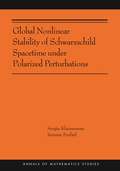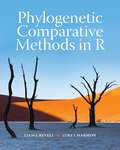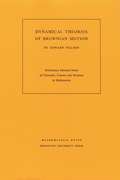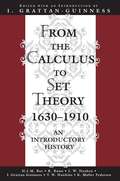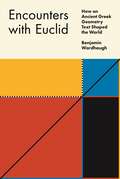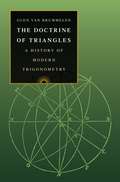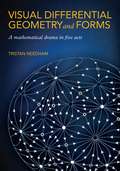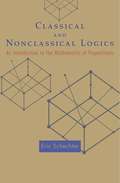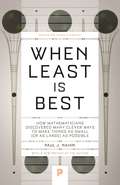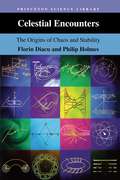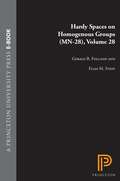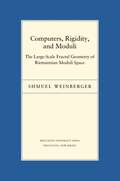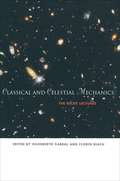- Table View
- List View
Chance and Chaos (Princeton Science Library #110)
by David RuelleHow do scientists look at chance, or randomness, and chaos in physical systems? In answering this question for a general audience, Ruelle writes in the best French tradition: he has produced an authoritative and elegant book--a model of clarity, succinctness, and a humor bordering at times on the sardonic.
Modernization and Postmodernization: Cultural, Economic, and Political Change in 43 Societies
by Ronald InglehartRonald Inglehart argues that economic development, cultural change, and political change go together in coherent and even, to some extent, predictable patterns. This is a controversial claim. It implies that some trajectories of socioeconomic change are more likely than others--and consequently that certain changes are foreseeable. Once a society has embarked on industrialization, for example, a whole syndrome of related changes, from mass mobilization to diminishing differences in gender roles, is likely to appear. These changes in worldviews seem to reflect changes in the economic and political environment, but they take place with a generational time lag and have considerable autonomy and momentum of their own. But industrialization is not the end of history. Advanced industrial society leads to a basic shift in values, de-emphasizing the instrumental rationality that characterized industrial society. Postmodern values then bring new societal changes, including democratic political institutions and the decline of state socialist regimes. To demonstrate the powerful links between belief systems and political and socioeconomic variables, this book draws on a unique database, the World Values Surveys. This database covers a broader range than ever before available for looking at the impact of mass publics on political and social life. It provides information from societies representing 70 percent of the world's population--from societies with per capita incomes as low as $300 per year to those with per capita incomes one hundred times greater and from long-established democracies with market economies to authoritarian states.
Cohomology of Quotients in Symplectic and Algebraic Geometry. (Mathematical Notes #104)
by Frances Clare KirwanThese notes describe a general procedure for calculating the Betti numbers of the projective quotient varieties that geometric invariant theory associates to reductive group actions on nonsingular complex projective varieties. These quotient varieties are interesting in particular because of their relevance to moduli problems in algebraic geometry. The author describes two different approaches to the problem. One is purely algebraic, while the other uses the methods of symplectic geometry and Morse theory, and involves extending classical Morse theory to certain degenerate functions.
A Mathematical Theory of Evidence
by Glenn ShaferBoth in science and in practical affairs we reason by combining facts only inconclusively supported by evidence. Building on an abstract understanding of this process of combination, this book constructs a new theory of epistemic probability. The theory draws on the work of A. P. Dempster but diverges from Depster's viewpoint by identifying his "lower probabilities" as epistemic probabilities and taking his rule for combining "upper and lower probabilities" as fundamental. The book opens with a critique of the well-known Bayesian theory of epistemic probability. It then proceeds to develop an alternative to the additive set functions and the rule of conditioning of the Bayesian theory: set functions that need only be what Choquet called "monotone of order of infinity." and Dempster's rule for combining such set functions. This rule, together with the idea of "weights of evidence," leads to both an extensive new theory and a better understanding of the Bayesian theory. The book concludes with a brief treatment of statistical inference and a discussion of the limitations of epistemic probability. Appendices contain mathematical proofs, which are relatively elementary and seldom depend on mathematics more advanced that the binomial theorem.
Polyominoes: Puzzles, Patterns, Problems, and Packings - Revised and Expanded Second Edition (Princeton Science Library #111)
by Solomon W. GolombInspiring popular video games like Tetris while contributing to the study of combinatorial geometry and tiling theory, polyominoes have continued to spark interest ever since their inventor, Solomon Golomb, introduced them to puzzle enthusiasts several decades ago. In this fully revised and expanded edition of his landmark book, the author takes a new generation of readers on a mathematical journey into the world of the deceptively simple polyomino. Golomb incorporates important, recent developments, and poses problems, inviting the reader to play with and develop an understanding of the extraordinary properties of polyominoes.
Stochastic Thermodynamics: An Introduction
by Luca Peliti Simone PigolottiThe first comprehensive graduate-level introduction to stochastic thermodynamicsStochastic thermodynamics is a well-defined subfield of statistical physics that aims to interpret thermodynamic concepts for systems ranging in size from a few to hundreds of nanometers, the behavior of which is inherently random due to thermal fluctuations. This growing field therefore describes the nonequilibrium dynamics of small systems, such as artificial nanodevices and biological molecular machines, which are of increasing scientific and technological relevance.This textbook provides an up-to-date pedagogical introduction to stochastic thermodynamics, guiding readers from basic concepts in statistical physics, probability theory, and thermodynamics to the most recent developments in the field. Gradually building up to more advanced material, the authors consistently prioritize simplicity and clarity over exhaustiveness and focus on the development of readers’ physical insight over mathematical formalism. This approach allows the reader to grow as the book proceeds, helping interested young scientists to enter the field with less effort and to contribute to its ongoing vibrant development. Chapters provide exercises to complement and reinforce learning.Appropriate for graduate students in physics and biophysics, as well as researchers, Stochastic Thermodynamics serves as an excellent initiation to this rapidly evolving field.Emphasizes a pedagogical approach to the subjectHighlights connections with the thermodynamics of informationPays special attention to molecular biophysics applicationsPrivileges physical intuition over mathematical formalismSolutions manual available on request for instructors adopting the book in a course
An Invitation to Modern Number Theory
by Steven J. Miller Ramin Takloo-BighashIn a manner accessible to beginning undergraduates, An Invitation to Modern Number Theory introduces many of the central problems, conjectures, results, and techniques of the field, such as the Riemann Hypothesis, Roth's Theorem, the Circle Method, and Random Matrix Theory. Showing how experiments are used to test conjectures and prove theorems, the book allows students to do original work on such problems, often using little more than calculus (though there are numerous remarks for those with deeper backgrounds). It shows students what number theory theorems are used for and what led to them and suggests problems for further research. Steven Miller and Ramin Takloo-Bighash introduce the problems and the computational skills required to numerically investigate them, providing background material (from probability to statistics to Fourier analysis) whenever necessary. They guide students through a variety of problems, ranging from basic number theory, cryptography, and Goldbach's Problem, to the algebraic structures of numbers and continued fractions, showing connections between these subjects and encouraging students to study them further. In addition, this is the first undergraduate book to explore Random Matrix Theory, which has recently become a powerful tool for predicting answers in number theory. Providing exercises, references to the background literature, and Web links to previous student research projects, An Invitation to Modern Number Theory can be used to teach a research seminar or a lecture class.
Lectures on Vector Bundles over Riemann Surfaces. (Mathematical Notes #105)
by Robert C. GunningThe description for this book, Lectures on Vector Bundles over Riemann Surfaces. (MN-6), Volume 6, will be forthcoming.
Honors Calculus
by Charles R. MacCluerThis is the first modern calculus book to be organized axiomatically and to survey the subject's applicability to science and engineering. A challenging exposition of calculus in the European style, it is an excellent text for a first-year university honors course or for a third-year analysis course. The calculus is built carefully from the axioms with all the standard results deduced from these axioms. The concise construction, by design, provides maximal flexibility for the instructor and allows the student to see the overall flow of the development. At the same time, the book reveals the origins of the calculus in celestial mechanics and number theory. The book introduces many topics often left to the appendixes in standard calculus textbooks and develops their connections with physics, engineering, and statistics. The author uses applications of derivatives and integrals to show how calculus is applied in these disciplines. Solutions to all exercises (even those involving proofs) are available to instructors upon request, making this book unique among texts in the field. Focuses on single variable calculus Provides a balance of precision and intuition Offers both routine and demanding exercises
Mathematics and Plausible Reasoning, Volume 1: Induction and Analogy in Mathematics
by G. PolyaA guide to the practical art of plausible reasoning, this book has relevance in every field of intellectual activity. Professor Polya, a world-famous mathematician from Stanford University, uses mathematics to show how hunches and guesses play an important part in even the most rigorously deductive science. He explains how solutions to problems can be guessed at; good guessing is often more important than rigorous deduction in finding correct solutions. Vol. I, on Induction and Analogy in Mathematics, covers a wide variety of mathematical problems, revealing the trains of thought that lead to solutions, pointing out false bypaths, discussing techniques of searching for proofs. Problems and examples challenge curiosity, judgment, and power of invention.
A Course in Complex Analysis
by Saeed ZakeriA comprehensive graduate-level textbook that takes a fresh approach to complex analysisA Course in Complex Analysis explores a central branch of mathematical analysis, with broad applications in mathematics and other fields such as physics and engineering. Ideally designed for a year-long graduate course on complex analysis and based on nearly twenty years of classroom lectures, this modern and comprehensive textbook is equally suited for independent study or as a reference for more experienced scholars.Saeed Zakeri guides the reader through a journey that highlights the topological and geometric themes of complex analysis and provides a solid foundation for more advanced studies, particularly in Riemann surfaces, conformal geometry, and dynamics. He presents all the main topics of classical theory in great depth and blends them seamlessly with many elegant developments that are not commonly found in textbooks at this level. They include the dynamics of Möbius transformations, Schlicht functions and distortion theorems, boundary behavior of conformal and harmonic maps, analytic arcs and the general reflection principle, Hausdorff dimension and holomorphic removability, a multifaceted approach to the theorems of Picard and Montel, Zalcman’s rescaling theorem, conformal metrics and Ahlfors’s generalization of the Schwarz lemma, holomorphic branched coverings, geometry of the modular group, and the uniformization theorem for spherical domains.Written with exceptional clarity and insightful style, A Course in Complex Analysis is accessible to beginning graduate students and advanced undergraduates with some background knowledge of analysis and topology. Zakeri includes more than 350 problems, with problem sets at the end of each chapter, along with numerous carefully selected examples. This well-organized and richly illustrated book is peppered throughout with marginal notes of historical and expository value.Presenting a wealth of material in a single volume, A Course in Complex Analysis will be a valuable resource for students and working mathematicians.
Global Nonlinear Stability of Schwarzschild Spacetime under Polarized Perturbations: (AMS-210) (Annals of Mathematics Studies #398)
by Jérémie Szeftel Sergiu KlainermanEssential mathematical insights into one of the most important and challenging open problems in general relativity—the stability of black holesOne of the major outstanding questions about black holes is whether they remain stable when subject to small perturbations. An affirmative answer to this question would provide strong theoretical support for the physical reality of black holes. In this book, Sergiu Klainerman and Jérémie Szeftel take a first important step toward solving the fundamental black hole stability problem in general relativity by establishing the stability of nonrotating black holes—or Schwarzschild spacetimes—under so-called polarized perturbations. This restriction ensures that the final state of evolution is itself a Schwarzschild space. Building on the remarkable advances made in the past fifteen years in establishing quantitative linear stability, Klainerman and Szeftel introduce a series of new ideas to deal with the strongly nonlinear, covariant features of the Einstein equations. Most preeminent among them is the general covariant modulation (GCM) procedure that allows them to determine the center of mass frame and the mass of the final black hole state. Essential reading for mathematicians and physicists alike, this book introduces a rich theoretical framework relevant to situations such as the full setting of the Kerr stability conjecture.
Phylogenetic Comparative Methods in R
by Liam J. Revell Luke J. HarmonAn authoritative introduction to the latest comparative methods in evolutionary biologyPhylogenetic comparative methods are a suite of statistical approaches that enable biologists to analyze and better understand the evolutionary tree of life, and shed vital new light on patterns of divergence and common ancestry among all species on Earth. This textbook shows how to carry out phylogenetic comparative analyses in the R statistical computing environment. Liam Revell and Luke Harmon provide an incisive conceptual overview of each method along with worked examples using real data and challenge problems that encourage students to learn by doing. By working through this book, students will gain a solid foundation in these methods and develop the skills they need to interpret patterns in the tree of life.Covers every major method of modern phylogenetic comparative analysis in RExplains the basics of R and discusses topics such as trait evolution, diversification, trait-dependent diversification, biogeography, and visualizationFeatures a wealth of exercises and challenge problemsServes as an invaluable resource for students and researchers, with applications in ecology, evolution, anthropology, disease transmission, conservation biology, and a host of other areasWritten by two of today’s leading developers of phylogenetic comparative methods
Dynamical Theories of Brownian Motion (Mathematical Notes #106)
by Edward NelsonThese notes are based on a course of lectures given by Professor Nelson at Princeton during the spring term of 1966. The subject of Brownian motion has long been of interest in mathematical probability. In these lectures, Professor Nelson traces the history of earlier work in Brownian motion, both the mathematical theory, and the natural phenomenon with its physical interpretations. He continues through recent dynamical theories of Brownian motion, and concludes with a discussion of the relevance of these theories to quantum field theory and quantum statistical mechanics.
From the Calculus to Set Theory 1630-1910: An Introductory History
by I. Grattan-GuinnessFrom the Calculus to Set Theory traces the development of the calculus from the early seventeenth century through its expansion into mathematical analysis to the developments in set theory and the foundations of mathematics in the early twentieth century. It chronicles the work of mathematicians from Descartes and Newton to Russell and Hilbert and many, many others while emphasizing foundational questions and underlining the continuity of developments in higher mathematics. The other contributors to this volume are H. J. M. Bos, R. Bunn, J. W. Dauben, T. W. Hawkins, and K. Møller-Pedersen.
Encounters with Euclid: How an Ancient Greek Geometry Text Shaped the World
by Benjamin WardhaughA sweeping cultural history of one of the most influential mathematical books ever writtenEuclid's Elements of Geometry is one of the fountainheads of mathematics—and of culture. Written around 300 BCE, it has traveled widely across the centuries, generating countless new ideas and inspiring such figures as Isaac Newton, Bertrand Russell, Abraham Lincoln, and Albert Einstein. Encounters with Euclid tells the story of this incomparable mathematical masterpiece, taking readers from its origins in the ancient world to its continuing influence today.In this lively and informative book, Benjamin Wardhaugh explains how Euclid’s text journeyed from antiquity to the Renaissance, introducing some of the many readers, copyists, and editors who left their mark on the Elements before handing it on. He shows how some read the book as a work of philosophy, while others viewed it as a practical guide to life. He examines the many different contexts in which Euclid's book and his geometry were put to use, from the Neoplatonic school at Athens and the artisans' studios of medieval Baghdad to the Jesuit mission in China and the workshops of Restoration London. Wardhaugh shows how the Elements inspired ideas in theology, art, and music, and how the book has acquired new relevance to the strange geometries of dark matter and curved space.Encounters with Euclid traces the life and afterlives of one of the most remarkable works of mathematics ever written, revealing its lasting role in the timeless search for order and reason in an unruly world.
The Doctrine of Triangles: A History of Modern Trigonometry
by Glen Van BrummelenAn interdisciplinary history of trigonometry from the mid-sixteenth century to the early twentiethThe Doctrine of Triangles offers an interdisciplinary history of trigonometry that spans four centuries, starting in 1550 and concluding in the 1900s. Glen Van Brummelen tells the story of trigonometry as it evolved from an instrument for understanding the heavens to a practical tool, used in fields such as surveying and navigation. In Europe, China, and America, trigonometry aided and was itself transformed by concurrent mathematical revolutions, as well as the rise of science and technology.Following its uses in mid-sixteenth-century Europe as the "foot of the ladder to the stars" and the mathematical helpmate of astronomy, trigonometry became a ubiquitous tool for modeling various phenomena, including animal populations and sound waves. In the late sixteenth century, trigonometry increasingly entered the physical world through the practical disciplines, and its societal reach expanded with the invention of logarithms. Calculus shifted mathematical reasoning from geometric to algebraic patterns of thought, and trigonometry’s participation in this new mathematical analysis grew, encouraging such innovations as complex numbers and non-Euclidean geometry. Meanwhile in China, trigonometry was evolving rapidly too, sometimes merging with indigenous forms of knowledge, and with Western discoveries. In the nineteenth century, trigonometry became even more integral to science and industry as a fundamental part of the science and engineering toolbox, and a staple subject in high school classrooms.A masterful combination of scholarly rigor and compelling narrative, The Doctrine of Triangles brings trigonometry’s rich historical past full circle into the modern era.
Visual Differential Geometry and Forms: A Mathematical Drama in Five Acts
by Tristan NeedhamAn inviting, intuitive, and visual exploration of differential geometry and formsVisual Differential Geometry and Forms fulfills two principal goals. In the first four acts, Tristan Needham puts the geometry back into differential geometry. Using 235 hand-drawn diagrams, Needham deploys Newton’s geometrical methods to provide geometrical explanations of the classical results. In the fifth act, he offers the first undergraduate introduction to differential forms that treats advanced topics in an intuitive and geometrical manner.Unique features of the first four acts include: four distinct geometrical proofs of the fundamentally important Global Gauss-Bonnet theorem, providing a stunning link between local geometry and global topology; a simple, geometrical proof of Gauss’s famous Theorema Egregium; a complete geometrical treatment of the Riemann curvature tensor of an n-manifold; and a detailed geometrical treatment of Einstein’s field equation, describing gravity as curved spacetime (General Relativity), together with its implications for gravitational waves, black holes, and cosmology. The final act elucidates such topics as the unification of all the integral theorems of vector calculus; the elegant reformulation of Maxwell’s equations of electromagnetism in terms of 2-forms; de Rham cohomology; differential geometry via Cartan’s method of moving frames; and the calculation of the Riemann tensor using curvature 2-forms. Six of the seven chapters of Act V can be read completely independently from the rest of the book.Requiring only basic calculus and geometry, Visual Differential Geometry and Forms provocatively rethinks the way this important area of mathematics should be considered and taught.
Classical and Nonclassical Logics: An Introduction to the Mathematics of Propositions
by Eric SchechterSo-called classical logic--the logic developed in the early twentieth century by Gottlob Frege, Bertrand Russell, and others--is computationally the simplest of the major logics, and it is adequate for the needs of most mathematicians. But it is just one of the many kinds of reasoning in everyday thought. Consequently, when presented by itself--as in most introductory texts on logic--it seems arbitrary and unnatural to students new to the subject. In Classical and Nonclassical Logics, Eric Schechter introduces classical logic alongside constructive, relevant, comparative, and other nonclassical logics. Such logics have been investigated for decades in research journals and advanced books, but this is the first textbook to make this subject accessible to beginners. While presenting an assortment of logics separately, it also conveys the deeper ideas (such as derivations and soundness) that apply to all logics. The book leads up to proofs of the Disjunction Property of constructive logic and completeness for several logics. The book begins with brief introductions to informal set theory and general topology, and avoids advanced algebra; thus it is self-contained and suitable for readers with little background in mathematics. It is intended primarily for undergraduate students with no previous experience of formal logic, but advanced students as well as researchers will also profit from this book.
When Least Is Best: How Mathematicians Discovered Many Clever Ways to Make Things as Small (or as Large) as Possible (Princeton Science Library #118)
by Paul J. NahinA mathematical journey through the most fascinating problems of extremes and how to solve themWhat is the best way to photograph a speeding bullet? How can lost hikers find their way out of a forest? Why does light move through glass in the least amount of time possible? When Least Is Best combines the mathematical history of extrema with contemporary examples to answer these intriguing questions and more. Paul Nahin shows how life often works at the extremes—with values becoming as small (or as large) as possible—and he considers how mathematicians over the centuries, including Descartes, Fermat, and Kepler, have grappled with these problems of minima and maxima. Throughout, Nahin examines entertaining conundrums, such as how to build the shortest bridge possible between two towns, how to vary speed during a race, and how to make the perfect basketball shot. Moving from medieval writings and modern calculus to the field of optimization, the engaging and witty explorations of When Least Is Best will delight math enthusiasts everywhere.
Celestial Encounters: The Origins of Chaos and Stability (Princeton Science Library)
by Florin Diacu Philip HolmesCelestial Encounters is for anyone who has ever wondered about the foundations of chaos. In 1888, the 34-year-old Henri Poincaré submitted a paper that was to change the course of science, but not before it underwent significant changes itself. "The Three-Body Problem and the Equations of Dynamics" won a prize sponsored by King Oscar II of Sweden and Norway and the journal Acta Mathematica, but after accepting the prize, Poincaré found a serious mistake in his work. While correcting it, he discovered the phenomenon of chaos. Starting with the story of Poincaré's work, Florin Diacu and Philip Holmes trace the history of attempts to solve the problems of celestial mechanics first posed in Isaac Newton's Principia in 1686. In describing how mathematical rigor was brought to bear on one of our oldest fascinations--the motions of the heavens--they introduce the people whose ideas led to the flourishing field now called nonlinear dynamics. In presenting the modern theory of dynamical systems, the models underlying much of modern science are described pictorially, using the geometrical language invented by Poincaré. More generally, the authors reflect on mathematical creativity and the roles that chance encounters, politics, and circumstance play in it.
Hardy Spaces on Homogeneous Groups. (Mathematical Notes #107)
by Gerald B. Folland Elias M. SteinThe object of this monograph is to give an exposition of the real-variable theory of Hardy spaces (HP spaces). This theory has attracted considerable attention in recent years because it led to a better understanding in Rn of such related topics as singular integrals, multiplier operators, maximal functions, and real-variable methods generally. Because of its fruitful development, a systematic exposition of some of the main parts of the theory is now desirable. In addition to this exposition, these notes contain a recasting of the theory in the more general setting where the underlying Rn is replaced by a homogeneous group.The justification for this wider scope comes from two sources: 1) the theory of semi-simple Lie groups and symmetric spaces, where such homogeneous groups arise naturally as "boundaries," and 2) certain classes of non-elliptic differential equations (in particular those connected with several complex variables), where the model cases occur on homogeneous groups. The example which has been most widely studied in recent years is that of the Heisenberg group.
Computers, Rigidity, and Moduli: The Large-Scale Fractal Geometry of Riemannian Moduli Space (Porter Lectures #20)
by Shmuel WeinbergerThis book is the first to present a new area of mathematical research that combines topology, geometry, and logic. Shmuel Weinberger seeks to explain and illustrate the implications of the general principle, first emphasized by Alex Nabutovsky, that logical complexity engenders geometric complexity. He provides applications to the problem of closed geodesics, the theory of submanifolds, and the structure of the moduli space of isometry classes of Riemannian metrics with curvature bounds on a given manifold. Ultimately, geometric complexity of a moduli space forces functions defined on that space to have many critical points, and new results about the existence of extrema or equilibria follow. The main sort of algorithmic problem that arises is recognition: is the presented object equivalent to some standard one? If it is difficult to determine whether the problem is solvable, then the original object has doppelgängers--that is, other objects that are extremely difficult to distinguish from it. Many new questions emerge about the algorithmic nature of known geometric theorems, about "dichotomy problems," and about the metric entropy of moduli space. Weinberger studies them using tools from group theory, computability, differential geometry, and topology, all of which he explains before use. Since several examples are worked out, the overarching principles are set in a clear relief that goes beyond the details of any one problem.
Classical and Celestial Mechanics: The Recife Lectures
by Hildeberto Cabral Florin DiacuThis book brings together a number of lectures given between 1993 and 1999 as part of a special series hosted by the Federal University of Pernambuco, in which internationally established researchers came to Recife, Brazil, to lecture on classical or celestial mechanics. Because of the high quality of the results and the general interest in the lecturers' topics, the editors have assembled nine of the lectures here in order to make them available to mathematicians and students around the world. The material presented includes a good balance of pure and applied research and of complete and incomplete results. Bringing together material that is otherwise quite scattered in the literature and including some important new results, it will serve graduate students and researchers interested in Hamiltonian dynamics and celestial mechanics. The contributors are Dieter Schmidt, Ernesto Pérez-Chavela, Mark Levi, Plácido Táboas and Jack Hale, Jair Koiller et al., Hildeberto Cabral, Florin Diacu, and Alain Albouy. The topics covered include central configurations and relative equilibria for the N-body problem, singularities of the N-body problem, the two-body problem, normal forms of Hamiltonian systems and stability of equilibria, applications to celestial mechanics of Poincaré's compactification, the motion of the moon, geometrical methods in mechanics, momentum maps and geometric phases, holonomy for gyrostats, microswimming, and bifurcation from families of periodic solutions.
Do Not Erase: Mathematicians and Their Chalkboards
by Jessica WynneA photographic exploration of mathematicians’ chalkboards“A mathematician, like a painter or poet, is a maker of patterns,” wrote the British mathematician G. H. Hardy. In Do Not Erase, photographer Jessica Wynne presents remarkable examples of this idea through images of mathematicians’ chalkboards. While other fields have replaced chalkboards with whiteboards and digital presentations, mathematicians remain loyal to chalk for puzzling out their ideas and communicating their research. Wynne offers more than one hundred stunning photographs of these chalkboards, gathered from a diverse group of mathematicians around the world. The photographs are accompanied by essays from each mathematician, reflecting on their work and processes. Together, pictures and words provide an illuminating meditation on the unique relationships among mathematics, art, and creativity.The mathematicians featured in this collection comprise exciting new voices alongside established figures, including Sun-Yung Alice Chang, Alain Connes, Misha Gromov, Andre Neves, Kasso Okoudjou, Peter Shor, Christina Sormani, Terence Tao, Claire Voisin, and many others. The companion essays give insights into how the chalkboard serves as a special medium for mathematical expression. The volume also includes an introduction by the author, an afterword by New Yorker writer Alec Wilkinson, and biographical information for each contributor.Do Not Erase is a testament to the myriad ways that mathematicians use their chalkboards to reveal the conceptual and visual beauty of their discipline—shapes, figures, formulas, and conjectures created through imagination, argument, and speculation.
